

How to Peer Edit an Essay: Free Peer Editing Checklist
If you want to peer edit an essay and are looking for some top tips, check out our free peer editing checklist.
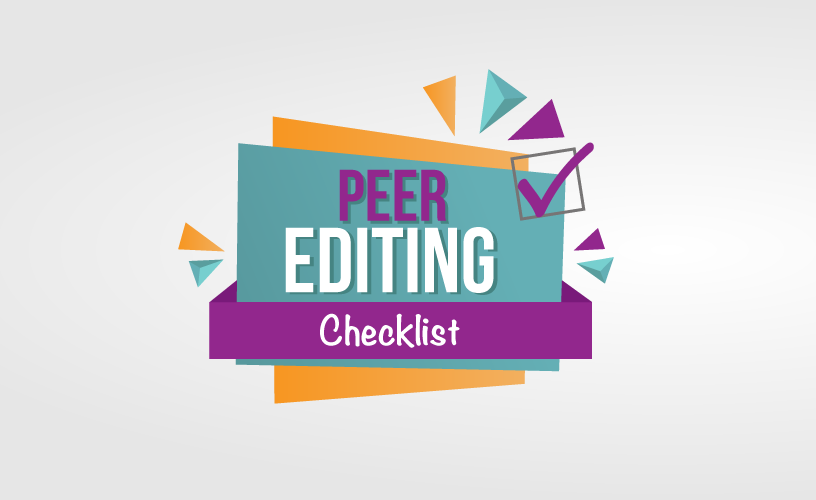
The idea of editing and proofreading your own essays, let alone asking someone else to help, may be beyond comprehension. In fact, you may think your essay is pretty fantastic already.
If so, you’re deceiving yourself.
Don’t just settle for good . You should be looking for great.
But how do you achieve this?
The majority of students settle for good. That’s enough. It will get them through school.
But good isn’t enough for the top students. They aspire to be great. They aspire to be awesome.
How do YOU become awesome?
Get a friend to help.
To take an essay beyond the draft stage through a polished version, you need a peer editor. It doesn’t necessarily have to be a professional essay editor (although that will deliver the best results); it needs to be someone who will call you out and tell you how it really is.
When you’re looking for someone to peer edit your essay, try and choose someone who you know well and who you can trust to be honest and methodical. You’re not looking for someone who’ll tell you how great your essay is; you’re looking for someone who will provide you with an objective criticism of your paper.
The purpose of the exercise isn’t to tear you down; it’s to make you better.
So, once you’ve found the ideal peer editor, how can you get the most out of the exercise?
Hand them our handy tips and the great peer editing checklist.
If you wish to edit your essay before engaging the help of a peer editor, take a look at our guide to essay editing .
How to Peer Edit an Essay: Top Tips for Success
Peer editors should review an essay with the primary intention of offering advice on how it can be improved. Here are some great tips to make sure you do the task justice.
Ideally, read through the paper at least twice
During the first pass, you’ll familiarize yourself with the content of the essay and the primary arguments that are put forth. During the second pass, you’ll have a chance to readily understand what is being said. If you don’t understand the content after two readings; there’s a problem the writer needs to know about.
Position yourself as the target reader
While you’re in the process of peer editing the essay, take the role of the envisioned reader; i.e., the person who is reading the essay to learn from someone as opposed to being on the hunt for pesky grammatical errors. During the peer editing process, you should be concerned with content, organization, and style. If you focus purely on punctuation and spelling errors, you may not add a significant amount of value. Your role is to help the writer ensure the essay is clear and compelling.
Resist the temptation to fix the issues
Your job as a peer editor is not to take over and correct any issues that you identify; it’s to provide the writer with constructive feedback on how the paper can be improved.
Tell the truth… constructively
If you’re peer editing a friend’s essay, you may not want to hurt his or her feelings by pointing out areas where there is a lack of clarity. However, if you fail to do so, there’s no point in engaging in the process. Resist the urge to say everything is fine and instead focus on how you can help the writer learn someone from the process. Provide constructive feedback that highlights the positive areas of the essay while also pointing out some areas for improvement.
Provide specific details
Don’t provide sweeping statements such as, “I don’t understand your point.” Instead, provide very precise feedback on what exactly you don’t understand and what information may help you understand it better: “Perhaps you could make your point clearer by explaining why…” Take every opportunity to explain why you found something effective or ineffective.
Check the style guide
Universities and colleges typically follow one of six major style guides in academic writing: APA, Harvard, MHRA, MLA , OSCOLA and Oxford. When you write in a consistent manner following a recognised style guide, it is simpler for readers to understand what to anticipate and where to find further information. Effective application of a style in formal writing will distinguish your work visually and ensure you meet the university’s requirements. If you’re using APA, take a look at our guide to APA formatting .
The Three Pillars of Excellent Peer Essay Editing
Free peer editing checklist.
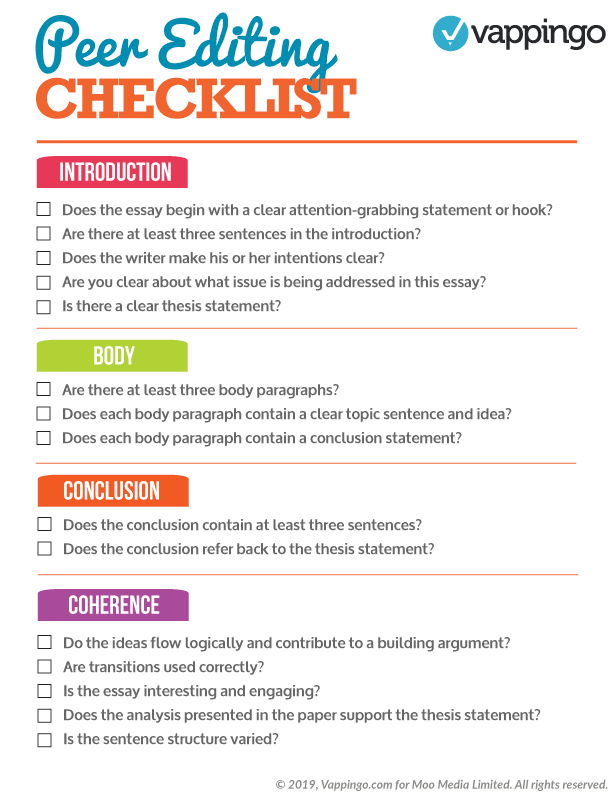
Download a free PDF version of our peer editing checklist by clicking on the image above. Here’s the full lowdown on what’s included.
Essay Introduction
- Does the essay begin with a clear, attention-grabbing statement or hook?
- Are there at least three sentences in the introduction?
- Does the writer make his or her intentions clear?
- Are you clear about what issue is being addressed in this essay?
- Is there a clear thesis statement?
See our guide to how to write an essay introduction for more help.
- Are there at least three body paragraphs?
- Does each body paragraph contain a clear topic sentence and idea?
- Does each body paragraph contain a conclusion statement that leads well to the next body paragraph?
- Does the conclusion contain at least three sentences?
- Does the conclusion refer back to the thesis statement?
Essay Flow and Coherence
- Do the ideas flow logically through the paper and contribute to a building argument?
- Have you used transitions correctly?
- Is the essay interesting?
- Does the analysis presented in the paper support the thesis statement?
- Is the sentence structure varied?
Essay Style and Mechanics
- Have you appropriately attributed and cited evidence?
- Have you cited each reference source according to the relevant style guide? If you’re using APA, take a look at our APA checklist .
- Is the paper formatted according to the relevant style guide?
- Are the references, tables, and figures formatted according to the relevant style guide?
- Have you proofread the paper? For a full proofreading checklist, take a look at our essay proofreading checklist.
- Misspelled words
- Grammatical mistakes
- Punctuation errors
- Run-on Sentences
So that’s our guide to how to peer edit an essay. Got anything to add? Please leave a comment.
4 thoughts on “How to Peer Edit an Essay: Free Peer Editing Checklist”
- Pingback: Editing an Essay the Easy Way in 2019
- Pingback: Peer Essay Editing Checklist | Essay Tips | How to Peer Edit an Essay www.vappingo.com/... - New Sites
- Pingback: Editing an Essay the Easy Way in 2020
- Pingback: How to Write an Essay Introduction: The Definitive Guide
Comments are closed.

Want to create or adapt books like this? Learn more about how Pressbooks supports open publishing practices.
8.4 Revising and Editing
Learning objectives.
- Identify major areas of concern in the draft essay during revising and editing.
- Use peer reviews and editing checklists to assist revising and editing.
- Revise and edit the first draft of your essay and produce a final draft.
Revising and editing are the two tasks you undertake to significantly improve your essay. Both are very important elements of the writing process. You may think that a completed first draft means little improvement is needed. However, even experienced writers need to improve their drafts and rely on peers during revising and editing. You may know that athletes miss catches, fumble balls, or overshoot goals. Dancers forget steps, turn too slowly, or miss beats. For both athletes and dancers, the more they practice, the stronger their performance will become. Web designers seek better images, a more clever design, or a more appealing background for their web pages. Writing has the same capacity to profit from improvement and revision.
Understanding the Purpose of Revising and Editing
Revising and editing allow you to examine two important aspects of your writing separately, so that you can give each task your undivided attention.
- When you revise , you take a second look at your ideas. You might add, cut, move, or change information in order to make your ideas clearer, more accurate, more interesting, or more convincing.
- When you edit , you take a second look at how you expressed your ideas. You add or change words. You fix any problems in grammar, punctuation, and sentence structure. You improve your writing style. You make your essay into a polished, mature piece of writing, the end product of your best efforts.
How do you get the best out of your revisions and editing? Here are some strategies that writers have developed to look at their first drafts from a fresh perspective. Try them over the course of this semester; then keep using the ones that bring results.
- Take a break. You are proud of what you wrote, but you might be too close to it to make changes. Set aside your writing for a few hours or even a day until you can look at it objectively.
- Ask someone you trust for feedback and constructive criticism.
- Pretend you are one of your readers. Are you satisfied or dissatisfied? Why?
- Use the resources that your college provides. Find out where your school’s writing lab is located and ask about the assistance they provide online and in person.
Many people hear the words critic , critical , and criticism and pick up only negative vibes that provoke feelings that make them blush, grumble, or shout. However, as a writer and a thinker, you need to learn to be critical of yourself in a positive way and have high expectations for your work. You also need to train your eye and trust your ability to fix what needs fixing. For this, you need to teach yourself where to look.
Creating Unity and Coherence
Following your outline closely offers you a reasonable guarantee that your writing will stay on purpose and not drift away from the controlling idea. However, when writers are rushed, are tired, or cannot find the right words, their writing may become less than they want it to be. Their writing may no longer be clear and concise, and they may be adding information that is not needed to develop the main idea.
When a piece of writing has unity , all the ideas in each paragraph and in the entire essay clearly belong and are arranged in an order that makes logical sense. When the writing has coherence , the ideas flow smoothly. The wording clearly indicates how one idea leads to another within a paragraph and from paragraph to paragraph.
Reading your writing aloud will often help you find problems with unity and coherence. Listen for the clarity and flow of your ideas. Identify places where you find yourself confused, and write a note to yourself about possible fixes.
Creating Unity
Sometimes writers get caught up in the moment and cannot resist a good digression. Even though you might enjoy such detours when you chat with friends, unplanned digressions usually harm a piece of writing.
Mariah stayed close to her outline when she drafted the three body paragraphs of her essay she tentatively titled “Digital Technology: The Newest and the Best at What Price?” But a recent shopping trip for an HDTV upset her enough that she digressed from the main topic of her third paragraph and included comments about the sales staff at the electronics store she visited. When she revised her essay, she deleted the off-topic sentences that affected the unity of the paragraph.
Read the following paragraph twice, the first time without Mariah’s changes, and the second time with them.
Nothing is more confusing to me than choosing among televisions. It confuses lots of people who want a new high-definition digital television (HDTV) with a large screen to watch sports and DVDs on. You could listen to the guys in the electronics store, but word has it they know little more than you do. They want to sell what they have in stock, not what best fits your needs. You face decisions you never had to make with the old, bulky picture-tube televisions. Screen resolution means the number of horizontal scan lines the screen can show. This resolution is often 1080p, or full HD, or 768p. The trouble is that if you have a smaller screen, 32 inches or 37 inches diagonal, you won’t be able to tell the difference with the naked eye. The 1080p televisions cost more, though, so those are what the salespeople want you to buy. They get bigger commissions. The other important decision you face as you walk around the sales floor is whether to get a plasma screen or an LCD screen. Now here the salespeople may finally give you decent info. Plasma flat-panel television screens can be much larger in diameter than their LCD rivals. Plasma screens show truer blacks and can be viewed at a wider angle than current LCD screens. But be careful and tell the salesperson you have budget constraints. Large flat-panel plasma screens are much more expensive than flat-screen LCD models. Don’t let someone make you by more television than you need!
Answer the following two questions about Mariah’s paragraph:
Collaboration
Please share with a classmate and compare your answers.
- Now start to revise the first draft of the essay you wrote in Section 8 “Writing Your Own First Draft” . Reread it to find any statements that affect the unity of your writing. Decide how best to revise.
When you reread your writing to find revisions to make, look for each type of problem in a separate sweep. Read it straight through once to locate any problems with unity. Read it straight through a second time to find problems with coherence. You may follow this same practice during many stages of the writing process.
Writing at Work
Many companies hire copyeditors and proofreaders to help them produce the cleanest possible final drafts of large writing projects. Copyeditors are responsible for suggesting revisions and style changes; proofreaders check documents for any errors in capitalization, spelling, and punctuation that have crept in. Many times, these tasks are done on a freelance basis, with one freelancer working for a variety of clients.
Creating Coherence
Careful writers use transitions to clarify how the ideas in their sentences and paragraphs are related. These words and phrases help the writing flow smoothly. Adding transitions is not the only way to improve coherence, but they are often useful and give a mature feel to your essays. Table 8.3 “Common Transitional Words and Phrases” groups many common transitions according to their purpose.
Table 8.3 Common Transitional Words and Phrases
After Maria revised for unity, she next examined her paragraph about televisions to check for coherence. She looked for places where she needed to add a transition or perhaps reword the text to make the flow of ideas clear. In the version that follows, she has already deleted the sentences that were off topic.
Many writers make their revisions on a printed copy and then transfer them to the version on-screen. They conventionally use a small arrow called a caret (^) to show where to insert an addition or correction.

1. Answer the following questions about Mariah’s revised paragraph.
2. Now return to the first draft of the essay you wrote in Section 8 “Writing Your Own First Draft” and revise it for coherence. Add transition words and phrases where they are needed, and make any other changes that are needed to improve the flow and connection between ideas.
Being Clear and Concise
Some writers are very methodical and painstaking when they write a first draft. Other writers unleash a lot of words in order to get out all that they feel they need to say. Do either of these composing styles match your style? Or is your composing style somewhere in between? No matter which description best fits you, the first draft of almost every piece of writing, no matter its author, can be made clearer and more concise.
If you have a tendency to write too much, you will need to look for unnecessary words. If you have a tendency to be vague or imprecise in your wording, you will need to find specific words to replace any overly general language.
Identifying Wordiness
Sometimes writers use too many words when fewer words will appeal more to their audience and better fit their purpose. Here are some common examples of wordiness to look for in your draft. Eliminating wordiness helps all readers, because it makes your ideas clear, direct, and straightforward.
Sentences that begin with There is or There are .
Wordy: There are two major experiments that the Biology Department sponsors.
Revised: The Biology Department sponsors two major experiments.
Sentences with unnecessary modifiers.
Wordy: Two extremely famous and well-known consumer advocates spoke eloquently in favor of the proposed important legislation.
Revised: Two well-known consumer advocates spoke in favor of the proposed legislation.
Sentences with deadwood phrases that add little to the meaning. Be judicious when you use phrases such as in terms of , with a mind to , on the subject of , as to whether or not , more or less , as far as…is concerned , and similar expressions. You can usually find a more straightforward way to state your point.
Wordy: As a world leader in the field of green technology, the company plans to focus its efforts in the area of geothermal energy.
A report as to whether or not to use geysers as an energy source is in the process of preparation.
Revised: As a world leader in green technology, the company plans to focus on geothermal energy.
A report about using geysers as an energy source is in preparation.
Sentences in the passive voice or with forms of the verb to be . Sentences with passive-voice verbs often create confusion, because the subject of the sentence does not perform an action. Sentences are clearer when the subject of the sentence performs the action and is followed by a strong verb. Use strong active-voice verbs in place of forms of to be , which can lead to wordiness. Avoid passive voice when you can.
Wordy: It might perhaps be said that using a GPS device is something that is a benefit to drivers who have a poor sense of direction.
Revised: Using a GPS device benefits drivers who have a poor sense of direction.
Sentences with constructions that can be shortened.
Wordy: The e-book reader, which is a recent invention, may become as commonplace as the cell phone.
My over-sixty uncle bought an e-book reader, and his wife bought an e-book reader, too.
Revised: The e-book reader, a recent invention, may become as commonplace as the cell phone.
My over-sixty uncle and his wife both bought e-book readers.
Now return once more to the first draft of the essay you have been revising. Check it for unnecessary words. Try making your sentences as concise as they can be.
Choosing Specific, Appropriate Words
Most college essays should be written in formal English suitable for an academic situation. Follow these principles to be sure that your word choice is appropriate. For more information about word choice, see Chapter 4 “Working with Words: Which Word Is Right?” .
- Avoid slang. Find alternatives to bummer , kewl , and rad .
- Avoid language that is overly casual. Write about “men and women” rather than “girls and guys” unless you are trying to create a specific effect. A formal tone calls for formal language.
- Avoid contractions. Use do not in place of don’t , I am in place of I’m , have not in place of haven’t , and so on. Contractions are considered casual speech.
- Avoid clichés. Overused expressions such as green with envy , face the music , better late than never , and similar expressions are empty of meaning and may not appeal to your audience.
- Be careful when you use words that sound alike but have different meanings. Some examples are allusion/illusion , complement/compliment , council/counsel , concurrent/consecutive , founder/flounder , and historic/historical . When in doubt, check a dictionary.
- Choose words with the connotations you want. Choosing a word for its connotations is as important in formal essay writing as it is in all kinds of writing. Compare the positive connotations of the word proud and the negative connotations of arrogant and conceited .
- Use specific words rather than overly general words. Find synonyms for thing , people , nice , good , bad , interesting , and other vague words. Or use specific details to make your exact meaning clear.
Now read the revisions Mariah made to make her third paragraph clearer and more concise. She has already incorporated the changes she made to improve unity and coherence.

1. Answer the following questions about Mariah’s revised paragraph:
2. Now return once more to your essay in progress. Read carefully for problems with word choice. Be sure that your draft is written in formal language and that your word choice is specific and appropriate.
Completing a Peer Review
After working so closely with a piece of writing, writers often need to step back and ask for a more objective reader. What writers most need is feedback from readers who can respond only to the words on the page. When they are ready, writers show their drafts to someone they respect and who can give an honest response about its strengths and weaknesses.
You, too, can ask a peer to read your draft when it is ready. After evaluating the feedback and assessing what is most helpful, the reader’s feedback will help you when you revise your draft. This process is called peer review .
You can work with a partner in your class and identify specific ways to strengthen each other’s essays. Although you may be uncomfortable sharing your writing at first, remember that each writer is working toward the same goal: a final draft that fits the audience and the purpose. Maintaining a positive attitude when providing feedback will put you and your partner at ease. The box that follows provides a useful framework for the peer review session.
Questions for Peer Review
Title of essay: ____________________________________________
Date: ____________________________________________
Writer’s name: ____________________________________________
Peer reviewer’s name: _________________________________________
- This essay is about____________________________________________.
- Your main points in this essay are____________________________________________.
- What I most liked about this essay is____________________________________________.
These three points struck me as your strongest:
These places in your essay are not clear to me:
a. Where: ____________________________________________
Needs improvement because__________________________________________
b. Where: ____________________________________________
Needs improvement because ____________________________________________
c. Where: ____________________________________________
The one additional change you could make that would improve this essay significantly is ____________________________________________.
One of the reasons why word-processing programs build in a reviewing feature is that workgroups have become a common feature in many businesses. Writing is often collaborative, and the members of a workgroup and their supervisors often critique group members’ work and offer feedback that will lead to a better final product.
Exchange essays with a classmate and complete a peer review of each other’s draft in progress. Remember to give positive feedback and to be courteous and polite in your responses. Focus on providing one positive comment and one question for more information to the author.
Using Feedback Objectively
The purpose of peer feedback is to receive constructive criticism of your essay. Your peer reviewer is your first real audience, and you have the opportunity to learn what confuses and delights a reader so that you can improve your work before sharing the final draft with a wider audience (or your intended audience).
It may not be necessary to incorporate every recommendation your peer reviewer makes. However, if you start to observe a pattern in the responses you receive from peer reviewers, you might want to take that feedback into consideration in future assignments. For example, if you read consistent comments about a need for more research, then you may want to consider including more research in future assignments.
Using Feedback from Multiple Sources
You might get feedback from more than one reader as you share different stages of your revised draft. In this situation, you may receive feedback from readers who do not understand the assignment or who lack your involvement with and enthusiasm for it.
You need to evaluate the responses you receive according to two important criteria:
- Determine if the feedback supports the purpose of the assignment.
- Determine if the suggested revisions are appropriate to the audience.
Then, using these standards, accept or reject revision feedback.
Work with two partners. Go back to Note 8.81 “Exercise 4” in this lesson and compare your responses to Activity A, about Mariah’s paragraph, with your partners’. Recall Mariah’s purpose for writing and her audience. Then, working individually, list where you agree and where you disagree about revision needs.
Editing Your Draft
If you have been incorporating each set of revisions as Mariah has, you have produced multiple drafts of your writing. So far, all your changes have been content changes. Perhaps with the help of peer feedback, you have made sure that you sufficiently supported your ideas. You have checked for problems with unity and coherence. You have examined your essay for word choice, revising to cut unnecessary words and to replace weak wording with specific and appropriate wording.
The next step after revising the content is editing. When you edit, you examine the surface features of your text. You examine your spelling, grammar, usage, and punctuation. You also make sure you use the proper format when creating your finished assignment.
Editing often takes time. Budgeting time into the writing process allows you to complete additional edits after revising. Editing and proofreading your writing helps you create a finished work that represents your best efforts. Here are a few more tips to remember about your readers:
- Readers do not notice correct spelling, but they do notice misspellings.
- Readers look past your sentences to get to your ideas—unless the sentences are awkward, poorly constructed, and frustrating to read.
- Readers notice when every sentence has the same rhythm as every other sentence, with no variety.
- Readers do not cheer when you use there , their , and they’re correctly, but they notice when you do not.
- Readers will notice the care with which you handled your assignment and your attention to detail in the delivery of an error-free document..
The first section of this book offers a useful review of grammar, mechanics, and usage. Use it to help you eliminate major errors in your writing and refine your understanding of the conventions of language. Do not hesitate to ask for help, too, from peer tutors in your academic department or in the college’s writing lab. In the meantime, use the checklist to help you edit your writing.
Editing Your Writing
- Are some sentences actually sentence fragments?
- Are some sentences run-on sentences? How can I correct them?
- Do some sentences need conjunctions between independent clauses?
- Does every verb agree with its subject?
- Is every verb in the correct tense?
- Are tense forms, especially for irregular verbs, written correctly?
- Have I used subject, object, and possessive personal pronouns correctly?
- Have I used who and whom correctly?
- Is the antecedent of every pronoun clear?
- Do all personal pronouns agree with their antecedents?
- Have I used the correct comparative and superlative forms of adjectives and adverbs?
- Is it clear which word a participial phrase modifies, or is it a dangling modifier?
Sentence Structure
- Are all my sentences simple sentences, or do I vary my sentence structure?
- Have I chosen the best coordinating or subordinating conjunctions to join clauses?
- Have I created long, overpacked sentences that should be shortened for clarity?
- Do I see any mistakes in parallel structure?
Punctuation
- Does every sentence end with the correct end punctuation?
- Can I justify the use of every exclamation point?
- Have I used apostrophes correctly to write all singular and plural possessive forms?
- Have I used quotation marks correctly?
Mechanics and Usage
- Can I find any spelling errors? How can I correct them?
- Have I used capital letters where they are needed?
- Have I written abbreviations, where allowed, correctly?
- Can I find any errors in the use of commonly confused words, such as to / too / two ?
Be careful about relying too much on spelling checkers and grammar checkers. A spelling checker cannot recognize that you meant to write principle but wrote principal instead. A grammar checker often queries constructions that are perfectly correct. The program does not understand your meaning; it makes its check against a general set of formulas that might not apply in each instance. If you use a grammar checker, accept the suggestions that make sense, but consider why the suggestions came up.
Proofreading requires patience; it is very easy to read past a mistake. Set your paper aside for at least a few hours, if not a day or more, so your mind will rest. Some professional proofreaders read a text backward so they can concentrate on spelling and punctuation. Another helpful technique is to slowly read a paper aloud, paying attention to every word, letter, and punctuation mark.
If you need additional proofreading help, ask a reliable friend, a classmate, or a peer tutor to make a final pass on your paper to look for anything you missed.
Remember to use proper format when creating your finished assignment. Sometimes an instructor, a department, or a college will require students to follow specific instructions on titles, margins, page numbers, or the location of the writer’s name. These requirements may be more detailed and rigid for research projects and term papers, which often observe the American Psychological Association (APA) or Modern Language Association (MLA) style guides, especially when citations of sources are included.
To ensure the format is correct and follows any specific instructions, make a final check before you submit an assignment.
With the help of the checklist, edit and proofread your essay.
Key Takeaways
- Revising and editing are the stages of the writing process in which you improve your work before producing a final draft.
- During revising, you add, cut, move, or change information in order to improve content.
- During editing, you take a second look at the words and sentences you used to express your ideas and fix any problems in grammar, punctuation, and sentence structure.
- Unity in writing means that all the ideas in each paragraph and in the entire essay clearly belong together and are arranged in an order that makes logical sense.
- Coherence in writing means that the writer’s wording clearly indicates how one idea leads to another within a paragraph and between paragraphs.
- Transitional words and phrases effectively make writing more coherent.
- Writing should be clear and concise, with no unnecessary words.
- Effective formal writing uses specific, appropriate words and avoids slang, contractions, clichés, and overly general words.
- Peer reviews, done properly, can give writers objective feedback about their writing. It is the writer’s responsibility to evaluate the results of peer reviews and incorporate only useful feedback.
- Remember to budget time for careful editing and proofreading. Use all available resources, including editing checklists, peer editing, and your institution’s writing lab, to improve your editing skills.
Writing for Success Copyright © 2015 by University of Minnesota is licensed under a Creative Commons Attribution-NonCommercial-ShareAlike 4.0 International License , except where otherwise noted.

- About NuWrite
- Writing Advice
- Engineering & Design
- General writing advice
- Academic integrity and avoiding plagiarism (Northwestern WCAS)
- Grammar and punctuation
- Analytical writing
- Research papers
- Graphics and visuals
- Conferences
- Peer editing sheets for drafts
- Peer feedback form literature seminar
- Peer review Asian diaspora freshman seminar
- Research draft peer review
- Research paper introduction peer response
- Research paper peer evaluation of claims
- Peer editing science papers
- Getting the most out of peer reviews
- Peer review guidelines for a personal essay
- Writing assignments
- Freshman seminar award essays
- Useful links with writing advice
- Grading criteria
- Global Health
- Writing in the Humanities
- Science Writing
- Social Science Writing
- Writing for Graduate or Professional School
- Writing Advice for International Students
- Faculty-Only Resources
Peer editing
Peer editing can be done during class time or electronically outside of class, as the documents below--from Northwestern instructors--illustrate. The questions that students respond to can vary according to the nature of the assignment and the purpose of the peer review.
peer editing sheets for drafts Peer editing sheets for two essay assignments in a freshman seminar. Providing very specific questions helps the editors give useful feedback and suggestions.
peer feedback form literature seminar Students exchange drafts in class, complete the peer feedback form, and then discuss their written comments with one another. Students submit the forms with their drafts so that I can read them. I frequently refer to their peers' comments when I am writing my own comments on their drafts.
peer review Asian diaspora freshman seminar Students do a close reading of one another's drafts to provide insight into what has and has not been conveyed by the draft.
research draft peer review Prompts peer reviewers to comment on key pieces of information, logical organization, and conclusion
research paper introduction peer response Prompts peer editor to comment on introduction, and prompts author to respond to those comments
research paper peer evaluation of claims Prompts peer editor to evaluate the paper's effectiveness in supporting claims and addressing counter-arguments
peer editing science papers Prompts peer editor to complete a checklist on the paper's content, structure, and grammar
getting the most out of peer reviews A link to NU's Writing Place that explains how to make sure you benefit from sharing your writing with peers
peer review guidelines for a personal essay These guidelines from a freshman seminar are aimed at pairs of students who are exchanging drafts before meeting individually with the instructor.

- Contact Northwestern University
- Campus Emergency Information
- University Policies
Northwestern University Library | 1970 Campus Drive, Evanston, IL 60208-2300 | Phone: 847.491.7658 | Fax: 847.491.8306 | Email: [email protected]
- Our Mission
A Framework for Teaching Students How to Peer Edit
Giving meaningful feedback on a peer’s work doesn’t come naturally to students. Try these tips to help students hone their editing skills.

Too often, asking students to edit each other’s writing results in superficial commentary. Many students are uncertain about how to provide meaningful feedback on a peer’s work.
One way to make peer review more effective is by scaffolding it, or breaking down the practice into several classes where students critique each other’s work in a more focused, incremental manner. Scaffolding allows students to identify and address a single type of error in an allotted time period. While it is a valuable process for all students, it is especially useful for English-language learners and learning-support students, who benefit from breaking tasks and information into more manageable components.
Deconstruct Constructive Criticism
Students need to learn how to give and receive criticism in a productive and respectful manner. Before embarking on a class-wide peer review activity, teachers might underscore the importance of responses that are forthright and civil. Mastering the art of giving valuable feedback that doesn’t offend will benefit students in nearly every professional and personal relationship they maintain.
Start by breaking down the two words: constructive and criticism . What do these words mean by themselves? What synonyms might apply to each word? Ask students to think of examples of ways they might offer constructive criticism on a peer’s writing. They can be as simple as “Remember to capitalize proper nouns” or “Restate your thesis in your final paragraph.” Underscore to students that the criticism must be specific and helpful. “Good job!” doesn’t suffice. Write their responses on one or two poster boards, and place them where students can see them and refer back to them throughout the process.
Provide samples of criticism for students to emulate. You may want to advise learners to attach positive feedback with constructive criticism. For example, “Your hook poses a good question, but it contains several grammar errors” or “You inserted this quotation correctly.”
As there is no definitive guide to constructive criticism, teachers and students are encouraged to discuss what constitutes responsible feedback to find a definition and standards that best suit the class.
Set Clear Plans
In the same way that instruction often demands that educators create the assessment first, teachers should prepare for the peer review at the beginning of any writing assignment. A scaffolded peer review can be time-consuming, so consider the length of the writing assignment to be assessed when making a determination about the class time required.
Before assigning writing, consider what writing skills you want your students to learn, review, or practice. The objectives will vary by class, and they should be articulated to students from the outset. Some teachers may have the class focus on writing an effective thesis, incorporating quotations, or adding in-text citations. In other classes, the objective may be reviewing capitalization or comma usage. Identify the skills that students are expected to practice writing and finding in each other’s papers.
Facilitate the Process
Scaffolding the peer review provides an opportunity for students to read a piece multiple times to assess different elements of writing. First the class reviews the objective as a whole group. Then peer pairs review their individual writing with a focus on the defined learning objective.
Some students may be reluctant to criticize peers’ work. Consider choosing peer-review partners instead of letting the students pick. This might cut down on students’ being fearful of offending their friends. Also, if the debrief period is generating little discussion, ask students to debrief with their partners as opposed to in front of the class. Give students a set of debrief prompts to focus their discussion, such as “Discuss the corrections you made.”
Encourage students to refer to the posters regarding constructive criticism examples, especially if someone has given an impolite criticism.
Debrief as a Class
After the pair reviews, debrief by discussing the findings as a class. The debrief can be an open-ended session in which the teacher encourages students to ask questions and voice misunderstandings about both writing and critiquing. The debrief can also be more structured and incorporate specific questions, such as “What is a challenge an editor or peer reviewer might face?” or “What is one element of your writing you wish to improve upon?” The debrief can also take the form of a small writing assignment, such as a reflective paragraph on the peer review process in which students summarize what they have learned as an editor and proofreader.
We want our students to be proficient writers and thinkers. Reviewing a peer’s work can help young people better understand the often difficult process of writing by challenging them to adopt a dynamic new role as critic.
- Peer Review Checklist
Each essay is made up of multiple parts. In order to have a strong essay each part must be logical and effective. In many cases essays will be written with a strong thesis, but the rest of the paper will be lacking; making the paper ineffective. An essay is only as strong as its weakest point.

Using a checklist to complete your review will allow you to rate each of the parts in the paper according to their strength. There are many different peer review checklists, but the one below should be helpful for your assignment.
- Is the thesis clear?
- Does the author use his or her own ideas in the thesis and argument?
- Is the significance of the problem in the paper explained? Is the significance compelling?
- Are the ideas developed logically and thoroughly?
- Does the author use ethos effectively?
- Does the author use pathos effectively?
- Are different viewpoints acknowledged?
- Are objections effectively handled?
- Does the author give adequate explanations about sources used?
- Are the sources well-integrated into the paper, or do they seem to be added in just for the sake of adding sources?
- Is the word choice specific, concrete and interesting?
- Are the sentences clear?
- Is the overall organization of the argument effective?
- Are the transitions between paragraphs smooth?
- Are there any grammatical errors?
Based on the rubric found at: Grading Rubric Template (Word)
- Authored by : J. Indigo Eriksen. Provided by : Blue Ridge Community College. License : CC BY-NC-SA: Attribution-NonCommercial-ShareAlike
- Image of checklist. Authored by : Jurgen Appelo. Located at : https://flic.kr/p/hykfe7 . License : CC BY: Attribution
- Peer Review Checklist. Authored by : Robin Parent. Provided by : Utah State University English Department. Project : USU Open CourseWare Initiative. License : CC BY-NC-SA: Attribution-NonCommercial-ShareAlike
- Table of Contents
Instructor Resources (Access Requires Login)
- Overview of Instructor Resources
An Overview of the Writing Process
- Introduction to the Writing Process
- Introduction to Writing
- Your Role as a Learner
- What is an Essay?
- Reading to Write
- Defining the Writing Process
- Videos: Prewriting Techniques
- Thesis Statements
- Organizing an Essay
- Creating Paragraphs
- Conclusions
- Editing and Proofreading
- Matters of Grammar, Mechanics, and Style
- Comparative Chart of Writing Strategies
Using Sources
- Quoting, Paraphrasing, and Avoiding Plagiarism
- Formatting the Works Cited Page (MLA)
- Citing Paraphrases and Summaries (APA)
- APA Citation Style, 6th edition: General Style Guidelines

Definition Essay
- Definitional Argument Essay
- How to Write a Definition Essay
- Critical Thinking
- Video: Thesis Explained
- Effective Thesis Statements
- Student Sample: Definition Essay
Narrative Essay
- Introduction to Narrative Essay
- Student Sample: Narrative Essay
- "Shooting an Elephant" by George Orwell
- "Sixty-nine Cents" by Gary Shteyngart
- Video: The Danger of a Single Story
- How to Write an Annotation
- How to Write a Summary
- Writing for Success: Narration
Illustration/Example Essay
- Introduction to Illustration/Example Essay
- "She's Your Basic L.O.L. in N.A.D" by Perri Klass
- "April & Paris" by David Sedaris
- Writing for Success: Illustration/Example
- Student Sample: Illustration/Example Essay
Compare/Contrast Essay
- Introduction to Compare/Contrast Essay
- "Disability" by Nancy Mairs
- "Friending, Ancient or Otherwise" by Alex Wright
- "A South African Storm" by Allison Howard
- Writing for Success: Compare/Contrast
- Student Sample: Compare/Contrast Essay
Cause-and-Effect Essay
- Introduction to Cause-and-Effect Essay
- "Cultural Baggage" by Barbara Ehrenreich
- "Women in Science" by K.C. Cole
- Writing for Success: Cause and Effect
- Student Sample: Cause-and-Effect Essay
Argument Essay
- Introduction to Argument Essay
- Rogerian Argument
- "The Case Against Torture," by Alisa Soloman
- "The Case for Torture" by Michael Levin
- How to Write a Summary by Paraphrasing Source Material
- Writing for Success: Argument
- Student Sample: Argument Essay
- Grammar/Mechanics Mini-lessons
- Mini-lesson: Subjects and Verbs, Irregular Verbs, Subject Verb Agreement
- Mini-lesson: Sentence Types
- Mini-lesson: Fragments I
- Mini-lesson: Run-ons and Comma Splices I
- Mini-lesson: Comma Usage
- Mini-lesson: Parallelism
- Mini-lesson: The Apostrophe
- Mini-lesson: Capital Letters
- Grammar Practice - Interactive Quizzes
- De Copia - Demonstration of the Variety of Language
- Style Exercise: Voice

English Current
ESL Lesson Plans, Tests, & Ideas
- North American Idioms
- Business Idioms
- Idioms Quiz
- Idiom Requests
- Proverbs Quiz & List
- Phrasal Verbs Quiz
- Basic Phrasal Verbs
- North American Idioms App
- A(n)/The: Help Understanding Articles
- The First & Second Conditional
- The Difference between 'So' & 'Too'
- The Difference between 'a few/few/a little/little'
- The Difference between "Other" & "Another"
- Check Your Level
- English Vocabulary
- Verb Tenses (Intermediate)
- Articles (A, An, The) Exercises
- Prepositions Exercises
- Irregular Verb Exercises
- Gerunds & Infinitives Exercises
- Discussion Questions
- Speech Topics
- Argumentative Essay Topics
- Top-rated Lessons
- Intermediate
- Upper-Intermediate
- Reading Lessons
- View Topic List
- Expressions for Everyday Situations
- Travel Agency Activity
- Present Progressive with Mr. Bean
- Work-related Idioms
- Adjectives to Describe Employees
- Writing for Tone, Tact, and Diplomacy
- Speaking Tactfully
- Advice on Monetizing an ESL Website
- Teaching your First Conversation Class
- How to Teach English Conversation
- Teaching Different Levels
- Teaching Grammar in Conversation Class
- Members' Home
- Update Billing Info.
- Cancel Subscription
- North American Proverbs Quiz & List
- North American Idioms Quiz
- Idioms App (Android)
- 'Be used to'" / 'Use to' / 'Get used to'
- Ergative Verbs and the Passive Voice
- Keywords & Verb Tense Exercises
- Irregular Verb List & Exercises
- Non-Progressive (State) Verbs
- Present Perfect vs. Past Simple
- Present Simple vs. Present Progressive
- Past Perfect vs. Past Simple
- Subject Verb Agreement
- The Passive Voice
- Subject & Object Relative Pronouns
- Relative Pronouns Where/When/Whose
- Commas in Adjective Clauses
- A/An and Word Sounds
- 'The' with Names of Places
- Understanding English Articles
- Article Exercises (All Levels)
- Yes/No Questions
- Wh-Questions
- How far vs. How long
- Affect vs. Effect
- A few vs. few / a little vs. little
- Boring vs. Bored
- Compliment vs. Complement
- Die vs. Dead vs. Death
- Expect vs. Suspect
- Experiences vs. Experience
- Go home vs. Go to home
- Had better vs. have to/must
- Have to vs. Have got to
- I.e. vs. E.g.
- In accordance with vs. According to
- Lay vs. Lie
- Make vs. Do
- In the meantime vs. Meanwhile
- Need vs. Require
- Notice vs. Note
- 'Other' vs 'Another'
- Pain vs. Painful vs. In Pain
- Raise vs. Rise
- So vs. Such
- So vs. So that
- Some vs. Some of / Most vs. Most of
- Sometimes vs. Sometime
- Too vs. Either vs. Neither
- Weary vs. Wary
- Who vs. Whom
- While vs. During
- While vs. When
- Wish vs. Hope
- 10 Common Writing Mistakes
- 34 Common English Mistakes
- First & Second Conditionals
- Comparative & Superlative Adjectives
- Determiners: This/That/These/Those
- Check Your English Level
- Grammar Quiz (Advanced)
- Vocabulary Test - Multiple Questions
- Vocabulary Quiz - Choose the Word
- Verb Tense Review (Intermediate)
- Verb Tense Exercises (All Levels)
- Conjunction Exercises
- List of Topics
- Business English
- Games for the ESL Classroom
- Pronunciation
- Teaching Your First Conversation Class
- How to Teach English Conversation Class
Argumentative Essay Peer-Editing Checklist
I use the below checklist with my students so they can improve the drafts of their argumentative essays . Feel free to use it (or edit it as long as you don't redistribute it) if you find it useful for your class. Note that there are APA-related questions.
There are two pages. The first page is for the prepared students who brought an essay draft to class to show their partners. The second page is for unprepared students who only have their essay in their heads (it's a verbal exercise). If your students are all prepared, then you can disregard the second page.

Peer-review Checklist Preview
Argumentative Essay Draft Peer-Editing Checklist
Pair-work : Answer the below questions based on your partner’s essay.
- The essay has a clear thesis statement presenting its stance at the end of the introduction paragraph. (YES/NO) If YES, write the essay’s thesis statement below:
- The essay presents a counter-argument to the author’s stance. (YES/NO) If YES, write the counter-argument points below:
- Can you easily find a refutation or response to each of the above points?
Point A: (YES/NO)
Point B: (YES/NO)
(Point C: (YES/NO))
- If YES, is the refutation persuasive? (YES/Somewhat/No)
- Does the essay ignore any obvious counter-arguments? (YES/NO) (Answer should be NO)
- Do the regular body paragraphs begin with a clear topic sentence that states the overall topic of the paragraph? (Example topic sentence: “ Furthermore, outsourcing can reduce company costs .” < If this were the topic sentence, then the whole paragraph would be about reducing costs.) (YES/NO)
- Does each paragraph have at least three sentences? (YES/NO)
If time allows…
- Does each in-text citation contain the author’s last name and the year of publication? (YES/NO)
- Count the number of authors cited. Do all of these authors appear in the References? (YES/NO)
- Are there any non-cited authors in the References? (YES/NO) (Answer should be NO)
- Are the References entries listed in alphabetical order?
- Do all sources accessed online have a DOI or URL?
- Are the sentences clear? Highlight the sentences you don’t understand.
Research Essay Worksheet – Verbal Explanation (Essay draft not Ready)
Part 1 (Pair Work) : Stance, Counter-argument, and Refutation
Present the below points to your partner about your essay. You do not need to write anything–explain it as clearly as possible verbally.
Stance/Thesis
- My essay argues that ….
Counter-argument
- Critics of this view argue that (1) ….
- Some people also might argue that (2) ….
Refutation/Response
- Point #1 is not (completely) true because ….
- Point #2 is not (completely) true because ….
Part 2 : Once finished, give feedback to each other. Consider the following points:
- Are the most obvious counter-arguments mentioned?
- Does the refutation address the specific points of the counter-argument?
- Is the refutation convincing
Part 3 : (Time Permitting) Verification of peer-reviewed sources
Paste a minimum of three peer-reviewed sources that you plan to use below.
Confirm with your partner that these sources are peer-reviewed, i.e. journal articles or published books.
Best of luck with your classes.
-- Peer-editing worksheet created by Matthew Barton (copyright) for Englishcurrent.com
EnglishCurrent is happily hosted on Dreamhost . If you found this page helpful, consider a donation to our hosting bill to show your support!
Leave a Reply Cancel reply
Your email address will not be published. Required fields are marked *

The Writing Process
Making expository writing less stressful, more efficient, and more enlightening, search form, you are here.
- Step 5: Edit
Personal Editing Checklist

"If you re-read your work, you can find on re-rereading a great deal of repetition can be avoided by re-reading and editing." —William Safire
Click to download and create your Personalized Editing Checklist.
informative peer editing checklist
All Formats
Resource types, all resource types.
- Rating Count
- Price (Ascending)
- Price (Descending)
- Most Recent
Informative peer editing checklist
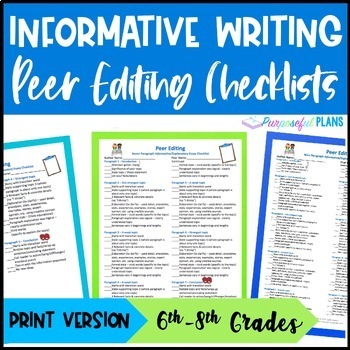
Peer Editing Checklist - 3 Informative /Expository Writing Peer Review Checklists

Peer Editing Checklists for Informative , Argumentative and Literary Analysis
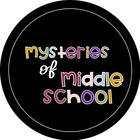
Peer Editing Checklist - 4 Informative /Expository Writing Peer Review Checklists
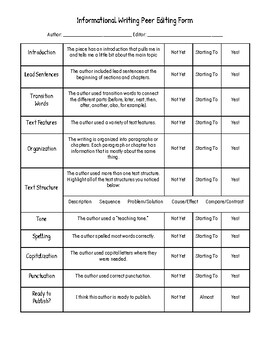
Informational Writing Peer Editing Checklist

Peer Editing Checklist - Informational Writing

Informational Paragraph Peer Revising and Editing Checklist (Editable)

- Word Document File

Informative Writing Peer Editing Checklist

Peer Editing Checklist -Expository/ Informational

Informative /Expository writing checklist for peer editing

Informative Essay Peer - Editing Checklist

Informational Writing - Peer Editing Checklist (With Sentence Frames)

Informational Writing - Self/ Peer Editing Checklist

- Google Slides™
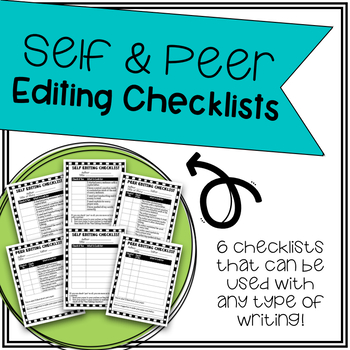
Self & Peer Editing Checklists - 6 Versions!

Halloween Opinion Writing Prompt Informational Text Passages - Graphic Organizer

ANIMAL REPORT: MAMMALS: INFORMATIONAL REPORT: RESEARCH TEMPLATES

ANIMAL REPORT: BIRDS: INFORMATIONAL REPORTS: RESEARCH TEMPLATES
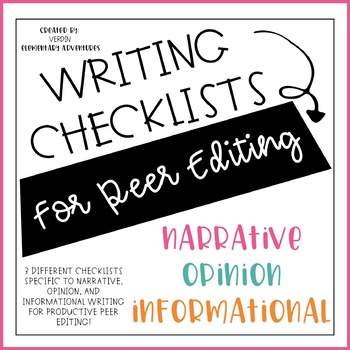
Peer Editing Checklists

ANIMAL REPORT: INSECTS: INFORMATIONAL REPORTS: RESEARCH TEMPLATES

Christmas Around The World Research Project Informational Writing Flipbooks

ICE AGE ANIMALS: INFORMATIONAL REPORT
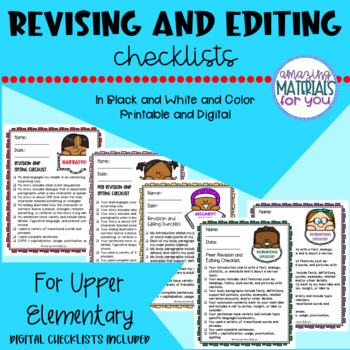
Writing Workshop | REVISING and EDITING Checklists PRINT and DIGITAL

- Google Apps™
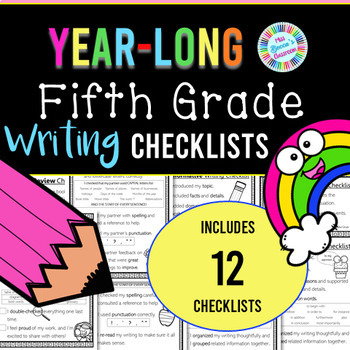
5th Grade Writing Checklists BUNDLE - Narrative, Informational , Editing , & MORE!
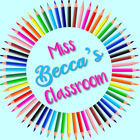
Cause and Effect Essay - Informative Essay Packet

Informative Writing Essay or Presentation Rubric & Checklist Assessment Tool

- We're hiring
- Help & FAQ
- Privacy policy
- Student privacy
- Terms of service
- Tell us what you think

IMAGES
VIDEO
COMMENTS
• Feedback can be oral or recorded on a variety of forms (e.g., checklist, scoring guide, written notes). • Partners should consider these categories during the review:
Editing Checklist for Self- and Peer Editing Directions: Edit your written work using the Self-Edit columns, fixing any errors you notice. Then, have a peer complete the Peer Edit columns while you observe. Self-Edit Peer Edit Checklist Items After completing each step, place a check here. Checklist Items After completing each step, place a ...
It is helpful to put the editing checklist on an overhead projector or document camera so all students can see the process. After the self-edit is complete, discuss the process with the students. Next, choose another student to serve as the peer editor for the piece that was just self-edited. Have the two students sit in the middle of the class ...
Position yourself as the target reader. While you're in the process of peer editing the essay, take the role of the envisioned reader; i.e., the person who is reading the essay to learn from someone as opposed to being on the hunt for pesky grammatical errors. During the peer editing process, you should be concerned with content, organization ...
DIRECTIONS: **This checklist must be submitted as proof of editing as evident by the "suggestions to improve column" below as well as revisions (changes) should be evident on the draft. Using a colored pen or pencil to revise is a good idea but not mandatory. Suggestions to Improve (This section must contain suggestion to improve the essay)
Directions: Each member of the group will proofread your paper. Each peer must write his/her name on the lines above. The first peer reads first answering ONLYthe content questions, and the second peer reads second answers ONLY the grammar questions. Then reverse it. This way each of you will submit one COMPLETED Peer editing sheet. Content ...
Revising and editing are the two tasks you undertake to significantly improve your essay. Both are very important elements of the writing process. You may think that a completed first draft means little improvement is needed. However, even experienced writers need to improve their drafts and rely on peers during revising and editing.
The essay is interesting. 3. Ideas/Content Everything in the essay supports the thesis statement. There is enough supporting evidence for each body paragraph. Descriptive and precise words are used. Sentence structure is varied (a mix of simple, compound, and complex sentences). 4. Grammar and Mechanics Point out any of the following that you find:
The Editing Checklist found below will help you focus on some key issues as you edit. There are two versions of the checklist below. The first is a printable PDF version, and the second is an interactive PDF version. In some browsers, you may need to download or save this file to be able to utilize all of its functionality.
List any emotionally charged words that the writer might want to change. List two facts that are particularly relevant and credible for making the reader want to consider the writer's viewpoint. List one idea that might need some work to accomplish the goal of making the reader consider the writer's viewpoint. Do ideas seem connected?
Peer editing can be done during class time or electronically outside of class, as the documents below--from Northwestern instructors--illustrate. The questions that students respond to can vary according to the nature of the assignment and the purpose of the peer review. Peer editing sheets for two essay assignments in a freshman seminar.
Scaffolding the peer review provides an opportunity for students to read a piece multiple times to assess different elements of writing. First the class reviews the objective as a whole group. Then peer pairs review their individual writing with a focus on the defined learning objective. Some students may be reluctant to criticize peers' work.
Peer Review Checklist. Each essay is made up of multiple parts. In order to have a strong essay each part must be logical and effective. In many cases essays will be written with a strong thesis, but the rest of the paper will be lacking; making the paper ineffective. An essay is only as strong as its weakest point.
Argumentative Essay Draft Peer-Editing Checklist. Pair-work: Answer the below questions based on your partner's essay. The essay has a clear thesis statement presenting its stance at the end of the introduction paragraph. (YES/NO) If YES, write the essay's thesis statement below: The essay presents a counter-argument to the author's stance.
I used paragraphs correctly. BODY PARAGRAPHS CHECKLIST. Body Paragraph 1. Contains a quality opening sentence that tells why I admire the person I chose. Gives details and examples of my topic sentence in this paragraph. Contains a closing sentence that successfully brings the paragraph to a close or transitions to the next. Body Paragraph 2.
Personal Editing Checklist. "If you re-read your work, you can find on re-rereading a great deal of repetition can be avoided by re-reading and editing." —William Safire. Click to download and create your Personalized Editing Checklist.
The checklist allows students to peer edit and give themselves a self-evaluation. The rubric comes with 2 versions - one with smiley faces and one with a 3,2,1 scale. This will make grading your s. Subjects: ... With this editable informative essay checklist, grading essays becomes much more efficient and much less time-consuming all at the ...
Students can use this resource to peer edit their classmates essays. This checklist provides students with explanations of what needs to be in each category of spelling, punctuation, capitalization, grammar, and evidence in their peers essay. This product allows students to checkmark when their peer's essay has the required field and mark on a ...
Sally Hansen - Purposeful Plans. 5.0. (11) $3.00. PDF. The 4 peer editing checklists are very detailed (for a 3, 4, 5, & 7 paragraph essay) created for the progressing writer. Excellent for mixed or leveled classes to give students individualized instruction. Practical and easy to understand.
The essay is interesting. 3. Ideas/Content Everything in the essay supports the thesis statement. There is enough supporting evidence for each body paragraph. Descriptive and precise words are used. Sentence structure is varied (a mix of simple, compound, and complex sentences). 4. Grammar and Mechanics Point out any of the following that you find:
5.0. (2) $2.50. Word Document File. Students use this document as a thorough checklist to go through a peer's paper with them and make revisions together (for the previous step of self-editing, please check my store for a very similarly thorough item!). The document is strategically designed for the teacher to be able to quickly see at a glance ...
Peer Editing Checklist Informative Essay WINTERS .pdf -... Doc Preview. Pages 3. Identified Q&As 17. Total views 8. Frederick Douglass High, Upper Marlboro. COLLEGE SUMMIT. COLLEGE SUMMIT 10. BaronStorkPerson269. 3/25/2022. View full document. Students also studied. MENGL-100 - Essay 4 Peer Review Part 2 (1).docx.
This resource can be used as a stand-alone flipbook or in an interactive notebook. What's Included: EDITABLE Flipbook templates (2-7) in blackline to print. Self- editing checklist Peer - editing checklist Teacher Marking Rubric x 4 formats Writin.